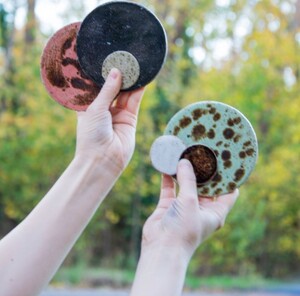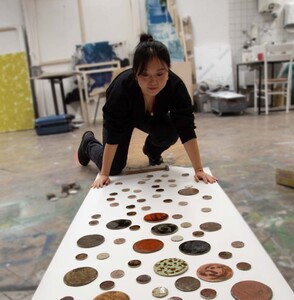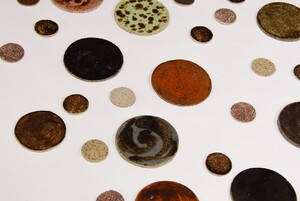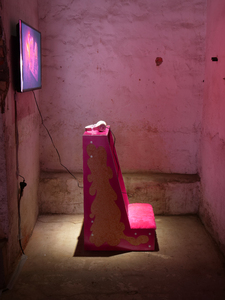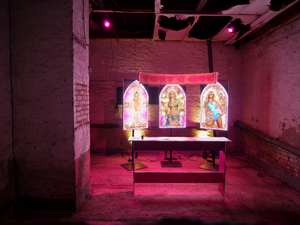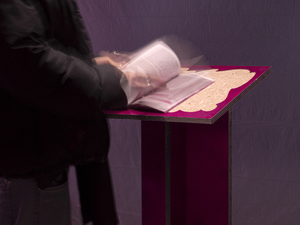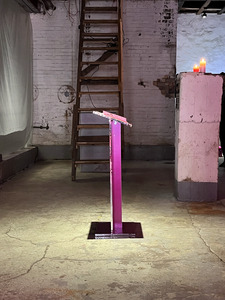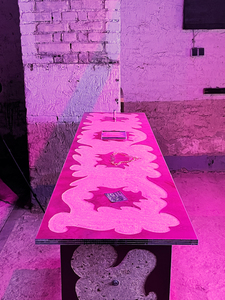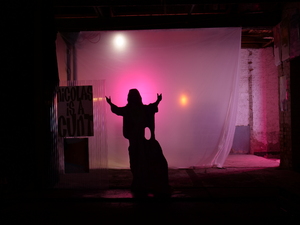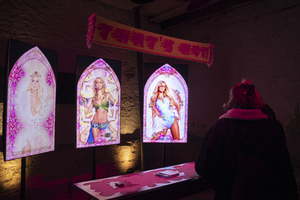"Display"
| Begriff | Display |
| Metakey | Beziehung/Funktion (media_object:relationship) |
| Typ | Keyword |
| Vokabular | Medienobjekt |
12 Inhalte
- Seite 1 von 1
AFTER FIRE SCALES
- Titel
- AFTER FIRE SCALES
- Titel
- AFTER FIRE SCALES
- Titel (en)
- AFTER FIRE SCALES
- Urheberrechtshinweis
- XINYI ZHAO
- Rechtsschutz/Lizenz
- Freigabe Nutzung HfG
- Medienersteller/in
- Beziehung/Funktion
- Medien-Beschreibung
- Von der Geschichte des Feuers bis zur Untersuchung seiner Bedeutung für die menschliche Gesellschaft habe ich eine Verbindung zwischen Feuer und Farben entdeckt: Metalle erzeugen unter bestimmten Verbrennungsbedingungen verschiedene Farben, die auch als wichtige Farbstoffe in der Glasurenherstellung dienen. Ich habe Zusammenhänge zwischen Metallen, Flammen, Farben und Glasuren gefunden, die auf den ersten Blick unzusammenhängend erscheinen, aber sich tatsächlich gegenseitig ergänzen. Mein Fokus liegt nun auf dem Stahlwerk in Kehl. Ich bin neugierig auf die verschiedenen Prozesse, die bei der Stahlerzeugung verwendet werden, sowie auf die entstehenden industriellen Nebenprodukte. Während meiner Recherchen stieß ich auf ein Nebenprodukt namens Schrott, das während des Walzprozesses entsteht, wenn die Oberfläche des Stahls mit Luft reagiert und hauptsächlich aus Eisenoxid besteht. Es ist ungiftig, aber aufgrund des niedrigen Eisengehalts ist das Recyclingkosten zu hoch, weshalb es oft von Stahlwerken zu einem niedrigen Preis verkauft und als Material für Straßenbau verwendet wird. Ich habe Kontakt mit dem Stahlwerk aufgenommen und etwa zehn Kilogramm dieses Materials aus Kehl erhalten. Ich habe darüber nachgedacht, wie ich dieses industrielle Nebenprodukt wieder verwenden kann, indem ich es durch Design-Upcycling verbessere, anstatt es abzubauen. Basierend auf meiner früheren Forschung zeigt Eisen als relativ aktives Metall in oxidativen und reduktiven Reaktionen bei unterschiedlichen Temperaturen eine reiche Farbpalette. Daher ist Eisen ein wichtiger Farbstoff in der Glasurenherstellung. Ich habe begonnen, das Schrott als Rohstoff in verschiedenen Mischungsverhältnissen mit anderen chemischen Elementen für Glasurexperimente zu verwenden, in der Hoffnung, die Möglichkeit zu sehen, Industrieabfälle in einer anderen Branche als Rohstoffe wiederzuverwenden. Das Ergebnis war überraschend; selbst auf den Testmustern zeigte das Schrott als Farbstoff Potenzial. Wenn die Forschung fortgesetzt wird, ist es möglich, neue Glasuren unter Verwendung verschiedener Industrieabfälle zu entwickeln. Durch diese Forschung sehe ich die Möglichkeiten des Designs in der modernen Industrie. Wenn Menschen mit Ressourcenknappheit und Umweltkrise konfrontiert sind, ist es dringend erforderlich, die Produktionsschritte, die sich aufgrund der industriellen Revolution einst unabhängig voneinander entwickelt haben, neu zu überdenken und die Verbindungen zwischen ihnen wiederherzustellen. Dies ist eine wichtige Fragestellung, über die zeitgenössisches Design nachdenken sollte.
- Medien-Beschreibung (en)
- From understanding the history of fire to researching its significance for human society, I discovered a connection between fire and colors: under specific combustion conditions, metallic elements produce various colors, which also serve as important colorants in glaze production. I found correlations between metals, flames, colors, and glazes, seemingly unrelated clues that actually complement each other. My focus now lies on the steelworks located in Kehl. I am curious about the various processes used in steelmaking and the resulting industrial by-products. During my research, I came across an industrial by-product called slag, which is formed during the steel rolling process when the surface of the steel reacts with air, primarily consisting of iron oxide. It is non-toxic, but due to its low iron content, the cost of recycling is too high, so it is often sold by steelworks at a low price and used as material for road embankments. I contacted the steelworks and obtained nearly ten kilograms of this material from Kehl. I began to consider how to reuse this industrial by-product by designing upgrades rather than downgrading it for disposal. Based on my previous research, iron, as a relatively active metal, exhibits a rich range of colors in oxidative and reductive reactions at different temperatures, making it an important colorant in glaze formulation. I started experimenting with the slag as a raw material in glaze formulations, mixing it with other chemical elements in different proportions, hoping to explore the possibility of industrial waste redevelopment in another industry. The result was surprising; even on the test samples, the slag showed potential as a colorant. If the research continues, it is possible to develop new glazes using various industrial wastes. Through this research, I see the possibilities of design in modern industry. When faced with resource depletion and environmental crisis, it is imperative to rethink the production steps that once developed independently due to the industrial revolution and to rediscover the connections between them. This is a critical issue for contemporary design to consider.
- From understanding the history of fire to researching its significance for human society, I discovered a connection between fire and colors: under specific combustion conditions, metallic elements produce various colors, which also serve as important colorants in glaze production. I found correlations between metals, flames, colors, and glazes, seemingly unrelated clues that actually complement each other. My focus now lies on the steelworks located in Kehl. I am curious about the various processes used in steelmaking and the resulting industrial by-products. During my research, I came across an industrial by-product called slag, which is formed during the steel rolling process when the surface of the steel reacts with air, primarily consisting of iron oxide. It is non-toxic, but due to its low iron content, the cost of recycling is too high, so it is often sold by steelworks at a low price and used as material for road embankments. I contacted the steelworks and obtained nearly ten kilograms of this material from Kehl. I began to consider how to reuse this industrial by-product by designing upgrades rather than downgrading it for disposal. Based on my previous research, iron, as a relatively active metal, exhibits a rich range of colors in oxidative and reductive reactions at different temperatures, making it an important colorant in glaze formulation. I started experimenting with the slag as a raw material in glaze formulations, mixing it with other chemical elements in different proportions, hoping to explore the possibility of industrial waste redevelopment in another industry. The result was surprising; even on the test samples, the slag showed potential as a colorant. If the research continues, it is possible to develop new glazes using various industrial wastes. Through this research, I see the possibilities of design in modern industry. When faced with resource depletion and environmental crisis, it is imperative to rethink the production steps that once developed independently due to the industrial revolution and to rediscover the connections between them. This is a critical issue for contemporary design to consider.
- Importiert am
- 10.06.2024
- Übergeordnete Sets
- 1
AFTER FIRE SCALES
- Titel
- AFTER FIRE SCALES
- Titel
- AFTER FIRE SCALES
- Titel (en)
- AFTER FIRE SCALES
- Urheberrechtshinweis
- ©XinyiZhao
- Rechtsschutz/Lizenz
- Freigabe Nutzung HfG
- Medienersteller/in
- Beziehung/Funktion
- Medien-Beschreibung
- Von der Geschichte des Feuers bis zur Untersuchung seiner Bedeutung für die menschliche Gesellschaft habe ich eine Verbindung zwischen Feuer und Farben entdeckt: Metalle erzeugen unter bestimmten Verbrennungsbedingungen verschiedene Farben, die auch als wichtige Farbstoffe in der Glasurenherstellung dienen. Ich habe Zusammenhänge zwischen Metallen, Flammen, Farben und Glasuren gefunden, die auf den ersten Blick unzusammenhängend erscheinen, aber sich tatsächlich gegenseitig ergänzen. Mein Fokus liegt nun auf dem Stahlwerk in Kehl. Ich bin neugierig auf die verschiedenen Prozesse, die bei der Stahlerzeugung verwendet werden, sowie auf die entstehenden industriellen Nebenprodukte. Während meiner Recherchen stieß ich auf ein Nebenprodukt namens Schrott, das während des Walzprozesses entsteht, wenn die Oberfläche des Stahls mit Luft reagiert und hauptsächlich aus Eisenoxid besteht. Es ist ungiftig, aber aufgrund des niedrigen Eisengehalts ist das Recyclingkosten zu hoch, weshalb es oft von Stahlwerken zu einem niedrigen Preis verkauft und als Material für Straßenbau verwendet wird. Ich habe Kontakt mit dem Stahlwerk aufgenommen und etwa zehn Kilogramm dieses Materials aus Kehl erhalten. Ich habe darüber nachgedacht, wie ich dieses industrielle Nebenprodukt wieder verwenden kann, indem ich es durch Design-Upcycling verbessere, anstatt es abzubauen. Basierend auf meiner früheren Forschung zeigt Eisen als relativ aktives Metall in oxidativen und reduktiven Reaktionen bei unterschiedlichen Temperaturen eine reiche Farbpalette. Daher ist Eisen ein wichtiger Farbstoff in der Glasurenherstellung. Ich habe begonnen, das Schrott als Rohstoff in verschiedenen Mischungsverhältnissen mit anderen chemischen Elementen für Glasurexperimente zu verwenden, in der Hoffnung, die Möglichkeit zu sehen, Industrieabfälle in einer anderen Branche als Rohstoffe wiederzuverwenden. Das Ergebnis war überraschend; selbst auf den Testmustern zeigte das Schrott als Farbstoff Potenzial. Wenn die Forschung fortgesetzt wird, ist es möglich, neue Glasuren unter Verwendung verschiedener Industrieabfälle zu entwickeln. Durch diese Forschung sehe ich die Möglichkeiten des Designs in der modernen Industrie. Wenn Menschen mit Ressourcenknappheit und Umweltkrise konfrontiert sind, ist es dringend erforderlich, die Produktionsschritte, die sich aufgrund der industriellen Revolution einst unabhängig voneinander entwickelt haben, neu zu überdenken und die Verbindungen zwischen ihnen wiederherzustellen. Dies ist eine wichtige Fragestellung, über die zeitgenössisches Design nachdenken sollte.
- Medien-Beschreibung (en)
- From understanding the history of fire to researching its significance for human society, I discovered a connection between fire and colors: under specific combustion conditions, metallic elements produce various colors, which also serve as important colorants in glaze production. I found correlations between metals, flames, colors, and glazes, seemingly unrelated clues that actually complement each other. My focus now lies on the steelworks located in Kehl. I am curious about the various processes used in steelmaking and the resulting industrial by-products. During my research, I came across an industrial by-product called slag, which is formed during the steel rolling process when the surface of the steel reacts with air, primarily consisting of iron oxide. It is non-toxic, but due to its low iron content, the cost of recycling is too high, so it is often sold by steelworks at a low price and used as material for road embankments. I contacted the steelworks and obtained nearly ten kilograms of this material from Kehl. I began to consider how to reuse this industrial by-product by designing upgrades rather than downgrading it for disposal. Based on my previous research, iron, as a relatively active metal, exhibits a rich range of colors in oxidative and reductive reactions at different temperatures, making it an important colorant in glaze formulation. I started experimenting with the slag as a raw material in glaze formulations, mixing it with other chemical elements in different proportions, hoping to explore the possibility of industrial waste redevelopment in another industry. The result was surprising; even on the test samples, the slag showed potential as a colorant. If the research continues, it is possible to develop new glazes using various industrial wastes. Through this research, I see the possibilities of design in modern industry. When faced with resource depletion and environmental crisis, it is imperative to rethink the production steps that once developed independently due to the industrial revolution and to rediscover the connections between them. This is a critical issue for contemporary design to consider.
- Importiert am
- 10.06.2024
- Übergeordnete Sets
- 1
AFTER FIRE SCALES
- Titel
- AFTER FIRE SCALES
- Titel
- AFTER FIRE SCALES
- Titel (en)
- AFTER FIRE SCALES
- Urheberrechtshinweis
- Xinyi Zhao
- Rechtsschutz/Lizenz
- Freigabe Nutzung HfG
- Medienersteller/in
- Beziehung/Funktion
- Medien-Beschreibung
- Von der Geschichte des Feuers bis zur Untersuchung seiner Bedeutung für die menschliche Gesellschaft habe ich eine Verbindung zwischen Feuer und Farben entdeckt: Metalle erzeugen unter bestimmten Verbrennungsbedingungen verschiedene Farben, die auch als wichtige Farbstoffe in der Glasurenherstellung dienen. Ich habe Zusammenhänge zwischen Metallen, Flammen, Farben und Glasuren gefunden, die auf den ersten Blick unzusammenhängend erscheinen, aber sich tatsächlich gegenseitig ergänzen. Mein Fokus liegt nun auf dem Stahlwerk in Kehl. Ich bin neugierig auf die verschiedenen Prozesse, die bei der Stahlerzeugung verwendet werden, sowie auf die entstehenden industriellen Nebenprodukte. Während meiner Recherchen stieß ich auf ein Nebenprodukt namens Schrott, das während des Walzprozesses entsteht, wenn die Oberfläche des Stahls mit Luft reagiert und hauptsächlich aus Eisenoxid besteht. Es ist ungiftig, aber aufgrund des niedrigen Eisengehalts ist das Recyclingkosten zu hoch, weshalb es oft von Stahlwerken zu einem niedrigen Preis verkauft und als Material für Straßenbau verwendet wird. Ich habe Kontakt mit dem Stahlwerk aufgenommen und etwa zehn Kilogramm dieses Materials aus Kehl erhalten. Ich habe darüber nachgedacht, wie ich dieses industrielle Nebenprodukt wieder verwenden kann, indem ich es durch Design-Upcycling verbessere, anstatt es abzubauen. Basierend auf meiner früheren Forschung zeigt Eisen als relativ aktives Metall in oxidativen und reduktiven Reaktionen bei unterschiedlichen Temperaturen eine reiche Farbpalette. Daher ist Eisen ein wichtiger Farbstoff in der Glasurenherstellung. Ich habe begonnen, das Schrott als Rohstoff in verschiedenen Mischungsverhältnissen mit anderen chemischen Elementen für Glasurexperimente zu verwenden, in der Hoffnung, die Möglichkeit zu sehen, Industrieabfälle in einer anderen Branche als Rohstoffe wiederzuverwenden. Das Ergebnis war überraschend; selbst auf den Testmustern zeigte das Schrott als Farbstoff Potenzial. Wenn die Forschung fortgesetzt wird, ist es möglich, neue Glasuren unter Verwendung verschiedener Industrieabfälle zu entwickeln. Durch diese Forschung sehe ich die Möglichkeiten des Designs in der modernen Industrie. Wenn Menschen mit Ressourcenknappheit und Umweltkrise konfrontiert sind, ist es dringend erforderlich, die Produktionsschritte, die sich aufgrund der industriellen Revolution einst unabhängig voneinander entwickelt haben, neu zu überdenken und die Verbindungen zwischen ihnen wiederherzustellen. Dies ist eine wichtige Fragestellung, über die zeitgenössisches Design nachdenken sollte.
- Medien-Beschreibung (en)
- From understanding the history of fire to researching its significance for human society, I discovered a connection between fire and colors: under specific combustion conditions, metallic elements produce various colors, which also serve as important colorants in glaze production. I found correlations between metals, flames, colors, and glazes, seemingly unrelated clues that actually complement each other. My focus now lies on the steelworks located in Kehl. I am curious about the various processes used in steelmaking and the resulting industrial by-products. During my research, I came across an industrial by-product called slag, which is formed during the steel rolling process when the surface of the steel reacts with air, primarily consisting of iron oxide. It is non-toxic, but due to its low iron content, the cost of recycling is too high, so it is often sold by steelworks at a low price and used as material for road embankments. I contacted the steelworks and obtained nearly ten kilograms of this material from Kehl. I began to consider how to reuse this industrial by-product by designing upgrades rather than downgrading it for disposal. Based on my previous research, iron, as a relatively active metal, exhibits a rich range of colors in oxidative and reductive reactions at different temperatures, making it an important colorant in glaze formulation. I started experimenting with the slag as a raw material in glaze formulations, mixing it with other chemical elements in different proportions, hoping to explore the possibility of industrial waste redevelopment in another industry. The result was surprising; even on the test samples, the slag showed potential as a colorant. If the research continues, it is possible to develop new glazes using various industrial wastes. Through this research, I see the possibilities of design in modern industry. When faced with resource depletion and environmental crisis, it is imperative to rethink the production steps that once developed independently due to the industrial revolution and to rediscover the connections between them. This is a critical issue for contemporary design to consider.
- Importiert am
- 10.06.2024
- Übergeordnete Sets
- 1
AFTER FIRE SCALES
- Titel
- AFTER FIRE SCALES
- Titel
- AFTER FIRE SCALES
- Titel (en)
- AFTER FIRE SCALES
- Urheberrechtshinweis
- XInyi Zhao
- Rechtsschutz/Lizenz
- Freigabe Nutzung HfG
- Medienersteller/in
- Beziehung/Funktion
- Medien-Beschreibung
- Von der Geschichte des Feuers bis zur Untersuchung seiner Bedeutung für die menschliche Gesellschaft habe ich eine Verbindung zwischen Feuer und Farben entdeckt: Metalle erzeugen unter bestimmten Verbrennungsbedingungen verschiedene Farben, die auch als wichtige Farbstoffe in der Glasurenherstellung dienen. Ich habe Zusammenhänge zwischen Metallen, Flammen, Farben und Glasuren gefunden, die auf den ersten Blick unzusammenhängend erscheinen, aber sich tatsächlich gegenseitig ergänzen. Mein Fokus liegt nun auf dem Stahlwerk in Kehl. Ich bin neugierig auf die verschiedenen Prozesse, die bei der Stahlerzeugung verwendet werden, sowie auf die entstehenden industriellen Nebenprodukte. Während meiner Recherchen stieß ich auf ein Nebenprodukt namens Schrott, das während des Walzprozesses entsteht, wenn die Oberfläche des Stahls mit Luft reagiert und hauptsächlich aus Eisenoxid besteht. Es ist ungiftig, aber aufgrund des niedrigen Eisengehalts ist das Recyclingkosten zu hoch, weshalb es oft von Stahlwerken zu einem niedrigen Preis verkauft und als Material für Straßenbau verwendet wird. Ich habe Kontakt mit dem Stahlwerk aufgenommen und etwa zehn Kilogramm dieses Materials aus Kehl erhalten. Ich habe darüber nachgedacht, wie ich dieses industrielle Nebenprodukt wieder verwenden kann, indem ich es durch Design-Upcycling verbessere, anstatt es abzubauen. Basierend auf meiner früheren Forschung zeigt Eisen als relativ aktives Metall in oxidativen und reduktiven Reaktionen bei unterschiedlichen Temperaturen eine reiche Farbpalette. Daher ist Eisen ein wichtiger Farbstoff in der Glasurenherstellung. Ich habe begonnen, das Schrott als Rohstoff in verschiedenen Mischungsverhältnissen mit anderen chemischen Elementen für Glasurexperimente zu verwenden, in der Hoffnung, die Möglichkeit zu sehen, Industrieabfälle in einer anderen Branche als Rohstoffe wiederzuverwenden. Das Ergebnis war überraschend; selbst auf den Testmustern zeigte das Schrott als Farbstoff Potenzial. Wenn die Forschung fortgesetzt wird, ist es möglich, neue Glasuren unter Verwendung verschiedener Industrieabfälle zu entwickeln. Durch diese Forschung sehe ich die Möglichkeiten des Designs in der modernen Industrie. Wenn Menschen mit Ressourcenknappheit und Umweltkrise konfrontiert sind, ist es dringend erforderlich, die Produktionsschritte, die sich aufgrund der industriellen Revolution einst unabhängig voneinander entwickelt haben, neu zu überdenken und die Verbindungen zwischen ihnen wiederherzustellen. Dies ist eine wichtige Fragestellung, über die zeitgenössisches Design nachdenken sollte.
- Medien-Beschreibung (en)
- From understanding the history of fire to researching its significance for human society, I discovered a connection between fire and colors: under specific combustion conditions, metallic elements produce various colors, which also serve as important colorants in glaze production. I found correlations between metals, flames, colors, and glazes, seemingly unrelated clues that actually complement each other. My focus now lies on the steelworks located in Kehl. I am curious about the various processes used in steelmaking and the resulting industrial by-products. During my research, I came across an industrial by-product called slag, which is formed during the steel rolling process when the surface of the steel reacts with air, primarily consisting of iron oxide. It is non-toxic, but due to its low iron content, the cost of recycling is too high, so it is often sold by steelworks at a low price and used as material for road embankments. I contacted the steelworks and obtained nearly ten kilograms of this material from Kehl. I began to consider how to reuse this industrial by-product by designing upgrades rather than downgrading it for disposal. Based on my previous research, iron, as a relatively active metal, exhibits a rich range of colors in oxidative and reductive reactions at different temperatures, making it an important colorant in glaze formulation. I started experimenting with the slag as a raw material in glaze formulations, mixing it with other chemical elements in different proportions, hoping to explore the possibility of industrial waste redevelopment in another industry. The result was surprising; even on the test samples, the slag showed potential as a colorant. If the research continues, it is possible to develop new glazes using various industrial wastes. Through this research, I see the possibilities of design in modern industry. When faced with resource depletion and environmental crisis, it is imperative to rethink the production steps that once developed independently due to the industrial revolution and to rediscover the connections between them. This is a critical issue for contemporary design to consider.
- Importiert am
- 10.06.2024
- Übergeordnete Sets
- 1
AUSSTELLUNG
- Titel
- AUSSTELLUNG
- Autor/in
- Beschreibung (de)
- WHERE LEGENDS ARE MADE AND LIES ARE TOLD (graduation project). Originated by this divine union of @parishilton @britneyspears @lindsaylohan (aka the Holy Trinity <3) the night of the infamous Bimbo Summit, WLAMALAT is the visual and critical translation of my obsession for the #y2k it-girls and #popculture in general. Mixing a religious with a highly commercial aesthetic, the project questions several topics such as women representation in the mass media, visual/celebrity culture consumption and new belief systems.
- WHERE LEGENDS ARE MADE AND LIES ARE TOLD (graduation project). Originated by this divine union of @parishilton @britneyspears @lindsaylohan (aka the Holy Trinity <3) the night of the infamous Bimbo Summit, WLAMALAT is the visual and critical translation of my obsession for the #y2k it-girls and #popculture in general. Mixing a religious with a highly commercial aesthetic, the project questions several topics such as women representation in the mass media, visual/celebrity culture consumption and new belief systems.
- Kategorie
- Typ des Projekts/Werks
- Datierung
- 06.12.23
- Mitwirkende
- Dank an
- Sprache
- Ort
- Rudolf 5
- Titel
- AUSSTELLUNG
- Urheberrechtshinweis
- ©Nicolas Poirot
- Medienersteller/in
- Beziehung/Funktion
- Medien-Beschreibung
- WHERE LEGENDS ARE MADE AND LIES ARE TOLD (graduation project). Originated by this divine union of @parishilton @britneyspears @lindsaylohan (aka the Holy Trinity <3) the night of the infamous Bimbo Summit, WLAMALAT is the visual and critical translation of my obsession for the #y2k it-girls and #popculture in general. Mixing a religious with a highly commercial aesthetic, the project questions several topics such as women representation in the mass media, visual/celebrity culture consumption and new belief systems.
- WHERE LEGENDS ARE MADE AND LIES ARE TOLD (graduation project). Originated by this divine union of @parishilton @britneyspears @lindsaylohan (aka the Holy Trinity <3) the night of the infamous Bimbo Summit, WLAMALAT is the visual and critical translation of my obsession for the #y2k it-girls and #popculture in general. Mixing a religious with a highly commercial aesthetic, the project questions several topics such as women representation in the mass media, visual/celebrity culture consumption and new belief systems.
- Projektleiter/in
- Semester
- Studiengang
- Typ der Abschlussarbeit
- Importiert am
- 05.11.2024
- Übergeordnete Sets
- 1
AUSSTELLUNG
- Titel
- AUSSTELLUNG
- Autor/in
- Beschreibung (de)
- WHERE LEGENDS ARE MADE AND LIES ARE TOLD (graduation project). Originated by this divine union of @parishilton @britneyspears @lindsaylohan (aka the Holy Trinity <3) the night of the infamous Bimbo Summit, WLAMALAT is the visual and critical translation of my obsession for the #y2k it-girls and #popculture in general. Mixing a religious with a highly commercial aesthetic, the project questions several topics such as women representation in the mass media, visual/celebrity culture consumption and new belief systems.
- WHERE LEGENDS ARE MADE AND LIES ARE TOLD (graduation project). Originated by this divine union of @parishilton @britneyspears @lindsaylohan (aka the Holy Trinity <3) the night of the infamous Bimbo Summit, WLAMALAT is the visual and critical translation of my obsession for the #y2k it-girls and #popculture in general. Mixing a religious with a highly commercial aesthetic, the project questions several topics such as women representation in the mass media, visual/celebrity culture consumption and new belief systems.
- Kategorie
- Typ des Projekts/Werks
- Datierung
- 06.12.23
- Mitwirkende
- Dank an
- Sprache
- Ort
- Rudolf 5
- Titel
- AUSSTELLUNG
- Urheberrechtshinweis
- ©Nicolas Poirot
- Medienersteller/in
- Beziehung/Funktion
- Medien-Beschreibung
- WHERE LEGENDS ARE MADE AND LIES ARE TOLD (graduation project). Originated by this divine union of @parishilton @britneyspears @lindsaylohan (aka the Holy Trinity <3) the night of the infamous Bimbo Summit, WLAMALAT is the visual and critical translation of my obsession for the #y2k it-girls and #popculture in general. Mixing a religious with a highly commercial aesthetic, the project questions several topics such as women representation in the mass media, visual/celebrity culture consumption and new belief systems.
- WHERE LEGENDS ARE MADE AND LIES ARE TOLD (graduation project). Originated by this divine union of @parishilton @britneyspears @lindsaylohan (aka the Holy Trinity <3) the night of the infamous Bimbo Summit, WLAMALAT is the visual and critical translation of my obsession for the #y2k it-girls and #popculture in general. Mixing a religious with a highly commercial aesthetic, the project questions several topics such as women representation in the mass media, visual/celebrity culture consumption and new belief systems.
- Projektleiter/in
- Semester
- Studiengang
- Typ der Abschlussarbeit
- Importiert am
- 05.11.2024
- Übergeordnete Sets
- 1
AUSSTELLUNG
- Titel
- AUSSTELLUNG
- Autor/in
- Beschreibung (de)
- WHERE LEGENDS ARE MADE AND LIES ARE TOLD (graduation project). Originated by this divine union of @parishilton @britneyspears @lindsaylohan (aka the Holy Trinity <3) the night of the infamous Bimbo Summit, WLAMALAT is the visual and critical translation of my obsession for the #y2k it-girls and #popculture in general. Mixing a religious with a highly commercial aesthetic, the project questions several topics such as women representation in the mass media, visual/celebrity culture consumption and new belief systems.
- WHERE LEGENDS ARE MADE AND LIES ARE TOLD (graduation project). Originated by this divine union of @parishilton @britneyspears @lindsaylohan (aka the Holy Trinity <3) the night of the infamous Bimbo Summit, WLAMALAT is the visual and critical translation of my obsession for the #y2k it-girls and #popculture in general. Mixing a religious with a highly commercial aesthetic, the project questions several topics such as women representation in the mass media, visual/celebrity culture consumption and new belief systems.
- Kategorie
- Typ des Projekts/Werks
- Datierung
- 06.12.23
- Mitwirkende
- Dank an
- Sprache
- Ort
- Rudolf 5
- Titel
- AUSSTELLUNG
- Urheberrechtshinweis
- ©Nicolas Poirot
- Medienersteller/in
- Beziehung/Funktion
- Medien-Beschreibung
- WHERE LEGENDS ARE MADE AND LIES ARE TOLD (graduation project). Originated by this divine union of @parishilton @britneyspears @lindsaylohan (aka the Holy Trinity <3) the night of the infamous Bimbo Summit, WLAMALAT is the visual and critical translation of my obsession for the #y2k it-girls and #popculture in general. Mixing a religious with a highly commercial aesthetic, the project questions several topics such as women representation in the mass media, visual/celebrity culture consumption and new belief systems.
- WHERE LEGENDS ARE MADE AND LIES ARE TOLD (graduation project). Originated by this divine union of @parishilton @britneyspears @lindsaylohan (aka the Holy Trinity <3) the night of the infamous Bimbo Summit, WLAMALAT is the visual and critical translation of my obsession for the #y2k it-girls and #popculture in general. Mixing a religious with a highly commercial aesthetic, the project questions several topics such as women representation in the mass media, visual/celebrity culture consumption and new belief systems.
- Projektleiter/in
- Semester
- Studiengang
- Typ der Abschlussarbeit
- Importiert am
- 05.11.2024
- Übergeordnete Sets
- 1
AUSSTELLUNG
- Titel
- AUSSTELLUNG
- Autor/in
- Beschreibung (de)
- WHERE LEGENDS ARE MADE AND LIES ARE TOLD (graduation project). Originated by this divine union of @parishilton @britneyspears @lindsaylohan (aka the Holy Trinity <3) the night of the infamous Bimbo Summit, WLAMALAT is the visual and critical translation of my obsession for the #y2k it-girls and #popculture in general. Mixing a religious with a highly commercial aesthetic, the project questions several topics such as women representation in the mass media, visual/celebrity culture consumption and new belief systems.
- WHERE LEGENDS ARE MADE AND LIES ARE TOLD (graduation project). Originated by this divine union of @parishilton @britneyspears @lindsaylohan (aka the Holy Trinity <3) the night of the infamous Bimbo Summit, WLAMALAT is the visual and critical translation of my obsession for the #y2k it-girls and #popculture in general. Mixing a religious with a highly commercial aesthetic, the project questions several topics such as women representation in the mass media, visual/celebrity culture consumption and new belief systems.
- Kategorie
- Typ des Projekts/Werks
- Datierung
- 06.12.23
- Mitwirkende
- Dank an
- Sprache
- Ort
- Rudolf 5
- Titel
- AUSSTELLUNG
- Urheberrechtshinweis
- ©Nicolas Poirot
- Medienersteller/in
- Beziehung/Funktion
- Medien-Beschreibung
- WHERE LEGENDS ARE MADE AND LIES ARE TOLD (graduation project). Originated by this divine union of @parishilton @britneyspears @lindsaylohan (aka the Holy Trinity <3) the night of the infamous Bimbo Summit, WLAMALAT is the visual and critical translation of my obsession for the #y2k it-girls and #popculture in general. Mixing a religious with a highly commercial aesthetic, the project questions several topics such as women representation in the mass media, visual/celebrity culture consumption and new belief systems.
- WHERE LEGENDS ARE MADE AND LIES ARE TOLD (graduation project). Originated by this divine union of @parishilton @britneyspears @lindsaylohan (aka the Holy Trinity <3) the night of the infamous Bimbo Summit, WLAMALAT is the visual and critical translation of my obsession for the #y2k it-girls and #popculture in general. Mixing a religious with a highly commercial aesthetic, the project questions several topics such as women representation in the mass media, visual/celebrity culture consumption and new belief systems.
- Projektleiter/in
- Semester
- Studiengang
- Typ der Abschlussarbeit
- Importiert am
- 05.11.2024
- Übergeordnete Sets
- 1
AUSSTELLUNG
- Titel
- AUSSTELLUNG
- Autor/in
- Beschreibung (de)
- WHERE LEGENDS ARE MADE AND LIES ARE TOLD (graduation project). Originated by this divine union of @parishilton @britneyspears @lindsaylohan (aka the Holy Trinity <3) the night of the infamous Bimbo Summit, WLAMALAT is the visual and critical translation of my obsession for the #y2k it-girls and #popculture in general. Mixing a religious with a highly commercial aesthetic, the project questions several topics such as women representation in the mass media, visual/celebrity culture consumption and new belief systems.
- WHERE LEGENDS ARE MADE AND LIES ARE TOLD (graduation project). Originated by this divine union of @parishilton @britneyspears @lindsaylohan (aka the Holy Trinity <3) the night of the infamous Bimbo Summit, WLAMALAT is the visual and critical translation of my obsession for the #y2k it-girls and #popculture in general. Mixing a religious with a highly commercial aesthetic, the project questions several topics such as women representation in the mass media, visual/celebrity culture consumption and new belief systems.
- Kategorie
- Typ des Projekts/Werks
- Datierung
- 06.12.23
- Mitwirkende
- Dank an
- Sprache
- Ort
- Rudolf 5
- Titel
- AUSSTELLUNG
- Urheberrechtshinweis
- ©Nicolas Poirot
- Medienersteller/in
- Beziehung/Funktion
- Medien-Beschreibung
- WHERE LEGENDS ARE MADE AND LIES ARE TOLD (graduation project). Originated by this divine union of @parishilton @britneyspears @lindsaylohan (aka the Holy Trinity <3) the night of the infamous Bimbo Summit, WLAMALAT is the visual and critical translation of my obsession for the #y2k it-girls and #popculture in general. Mixing a religious with a highly commercial aesthetic, the project questions several topics such as women representation in the mass media, visual/celebrity culture consumption and new belief systems.
- WHERE LEGENDS ARE MADE AND LIES ARE TOLD (graduation project). Originated by this divine union of @parishilton @britneyspears @lindsaylohan (aka the Holy Trinity <3) the night of the infamous Bimbo Summit, WLAMALAT is the visual and critical translation of my obsession for the #y2k it-girls and #popculture in general. Mixing a religious with a highly commercial aesthetic, the project questions several topics such as women representation in the mass media, visual/celebrity culture consumption and new belief systems.
- Projektleiter/in
- Semester
- Studiengang
- Typ der Abschlussarbeit
- Importiert am
- 05.11.2024
- Übergeordnete Sets
- 1
AUSSTELLUNG
- Titel
- AUSSTELLUNG
- Autor/in
- Beschreibung (de)
- WHERE LEGENDS ARE MADE AND LIES ARE TOLD (graduation project). Originated by this divine union of @parishilton @britneyspears @lindsaylohan (aka the Holy Trinity <3) the night of the infamous Bimbo Summit, WLAMALAT is the visual and critical translation of my obsession for the #y2k it-girls and #popculture in general. Mixing a religious with a highly commercial aesthetic, the project questions several topics such as women representation in the mass media, visual/celebrity culture consumption and new belief systems.
- WHERE LEGENDS ARE MADE AND LIES ARE TOLD (graduation project). Originated by this divine union of @parishilton @britneyspears @lindsaylohan (aka the Holy Trinity <3) the night of the infamous Bimbo Summit, WLAMALAT is the visual and critical translation of my obsession for the #y2k it-girls and #popculture in general. Mixing a religious with a highly commercial aesthetic, the project questions several topics such as women representation in the mass media, visual/celebrity culture consumption and new belief systems.
- Kategorie
- Typ des Projekts/Werks
- Datierung
- 06.12.23
- Mitwirkende
- Dank an
- Sprache
- Ort
- Rudolf 5
- Titel
- AUSSTELLUNG
- Urheberrechtshinweis
- ©Nicolas Poirot
- Medienersteller/in
- Beziehung/Funktion
- Medien-Beschreibung
- WHERE LEGENDS ARE MADE AND LIES ARE TOLD (graduation project). Originated by this divine union of @parishilton @britneyspears @lindsaylohan (aka the Holy Trinity <3) the night of the infamous Bimbo Summit, WLAMALAT is the visual and critical translation of my obsession for the #y2k it-girls and #popculture in general. Mixing a religious with a highly commercial aesthetic, the project questions several topics such as women representation in the mass media, visual/celebrity culture consumption and new belief systems.
- WHERE LEGENDS ARE MADE AND LIES ARE TOLD (graduation project). Originated by this divine union of @parishilton @britneyspears @lindsaylohan (aka the Holy Trinity <3) the night of the infamous Bimbo Summit, WLAMALAT is the visual and critical translation of my obsession for the #y2k it-girls and #popculture in general. Mixing a religious with a highly commercial aesthetic, the project questions several topics such as women representation in the mass media, visual/celebrity culture consumption and new belief systems.
- Projektleiter/in
- Semester
- Studiengang
- Typ der Abschlussarbeit
- Importiert am
- 05.11.2024
- Übergeordnete Sets
- 1
AUSSTELLUNG
- Titel
- AUSSTELLUNG
- Autor/in
- Beschreibung (de)
- WHERE LEGENDS ARE MADE AND LIES ARE TOLD (graduation project). Originated by this divine union of @parishilton @britneyspears @lindsaylohan (aka the Holy Trinity <3) the night of the infamous Bimbo Summit, WLAMALAT is the visual and critical translation of my obsession for the #y2k it-girls and #popculture in general. Mixing a religious with a highly commercial aesthetic, the project questions several topics such as women representation in the mass media, visual/celebrity culture consumption and new belief systems.
- WHERE LEGENDS ARE MADE AND LIES ARE TOLD (graduation project). Originated by this divine union of @parishilton @britneyspears @lindsaylohan (aka the Holy Trinity <3) the night of the infamous Bimbo Summit, WLAMALAT is the visual and critical translation of my obsession for the #y2k it-girls and #popculture in general. Mixing a religious with a highly commercial aesthetic, the project questions several topics such as women representation in the mass media, visual/celebrity culture consumption and new belief systems.
- Kategorie
- Typ des Projekts/Werks
- Datierung
- 06.12.23
- Mitwirkende
- Dank an
- Sprache
- Ort
- Rudolf 5
- Titel
- AUSSTELLUNG
- Urheberrechtshinweis
- ©Nicolas Poirot
- Medienersteller/in
- Beziehung/Funktion
- Medien-Beschreibung
- WHERE LEGENDS ARE MADE AND LIES ARE TOLD (graduation project). Originated by this divine union of @parishilton @britneyspears @lindsaylohan (aka the Holy Trinity <3) the night of the infamous Bimbo Summit, WLAMALAT is the visual and critical translation of my obsession for the #y2k it-girls and #popculture in general. Mixing a religious with a highly commercial aesthetic, the project questions several topics such as women representation in the mass media, visual/celebrity culture consumption and new belief systems.
- WHERE LEGENDS ARE MADE AND LIES ARE TOLD (graduation project). Originated by this divine union of @parishilton @britneyspears @lindsaylohan (aka the Holy Trinity <3) the night of the infamous Bimbo Summit, WLAMALAT is the visual and critical translation of my obsession for the #y2k it-girls and #popculture in general. Mixing a religious with a highly commercial aesthetic, the project questions several topics such as women representation in the mass media, visual/celebrity culture consumption and new belief systems.
- Projektleiter/in
- Semester
- Studiengang
- Typ der Abschlussarbeit
- Importiert am
- 05.11.2024
- Übergeordnete Sets
- 1
AUSSTELLUNG
- Titel
- AUSSTELLUNG
- Autor/in
- Beschreibung (de)
- WHERE LEGENDS ARE MADE AND LIES ARE TOLD (graduation project). Originated by this divine union of @parishilton @britneyspears @lindsaylohan (aka the Holy Trinity <3) the night of the infamous Bimbo Summit, WLAMALAT is the visual and critical translation of my obsession for the #y2k it-girls and #popculture in general. Mixing a religious with a highly commercial aesthetic, the project questions several topics such as women representation in the mass media, visual/celebrity culture consumption and new belief systems.
- WHERE LEGENDS ARE MADE AND LIES ARE TOLD (graduation project). Originated by this divine union of @parishilton @britneyspears @lindsaylohan (aka the Holy Trinity <3) the night of the infamous Bimbo Summit, WLAMALAT is the visual and critical translation of my obsession for the #y2k it-girls and #popculture in general. Mixing a religious with a highly commercial aesthetic, the project questions several topics such as women representation in the mass media, visual/celebrity culture consumption and new belief systems.
- Kategorie
- Typ des Projekts/Werks
- Datierung
- 06.12.23
- Mitwirkende
- Dank an
- Sprache
- Ort
- Rudolf 5
- Titel
- AUSSTELLUNG
- Urheberrechtshinweis
- ©Nicolas Poirot
- Medienersteller/in
- Beziehung/Funktion
- Medien-Beschreibung
- WHERE LEGENDS ARE MADE AND LIES ARE TOLD (graduation project). Originated by this divine union of @parishilton @britneyspears @lindsaylohan (aka the Holy Trinity <3) the night of the infamous Bimbo Summit, WLAMALAT is the visual and critical translation of my obsession for the #y2k it-girls and #popculture in general. Mixing a religious with a highly commercial aesthetic, the project questions several topics such as women representation in the mass media, visual/celebrity culture consumption and new belief systems.
- WHERE LEGENDS ARE MADE AND LIES ARE TOLD (graduation project). Originated by this divine union of @parishilton @britneyspears @lindsaylohan (aka the Holy Trinity <3) the night of the infamous Bimbo Summit, WLAMALAT is the visual and critical translation of my obsession for the #y2k it-girls and #popculture in general. Mixing a religious with a highly commercial aesthetic, the project questions several topics such as women representation in the mass media, visual/celebrity culture consumption and new belief systems.
- Projektleiter/in
- Semester
- Studiengang
- Typ der Abschlussarbeit
- Importiert am
- 05.11.2024
- Übergeordnete Sets
- 1
